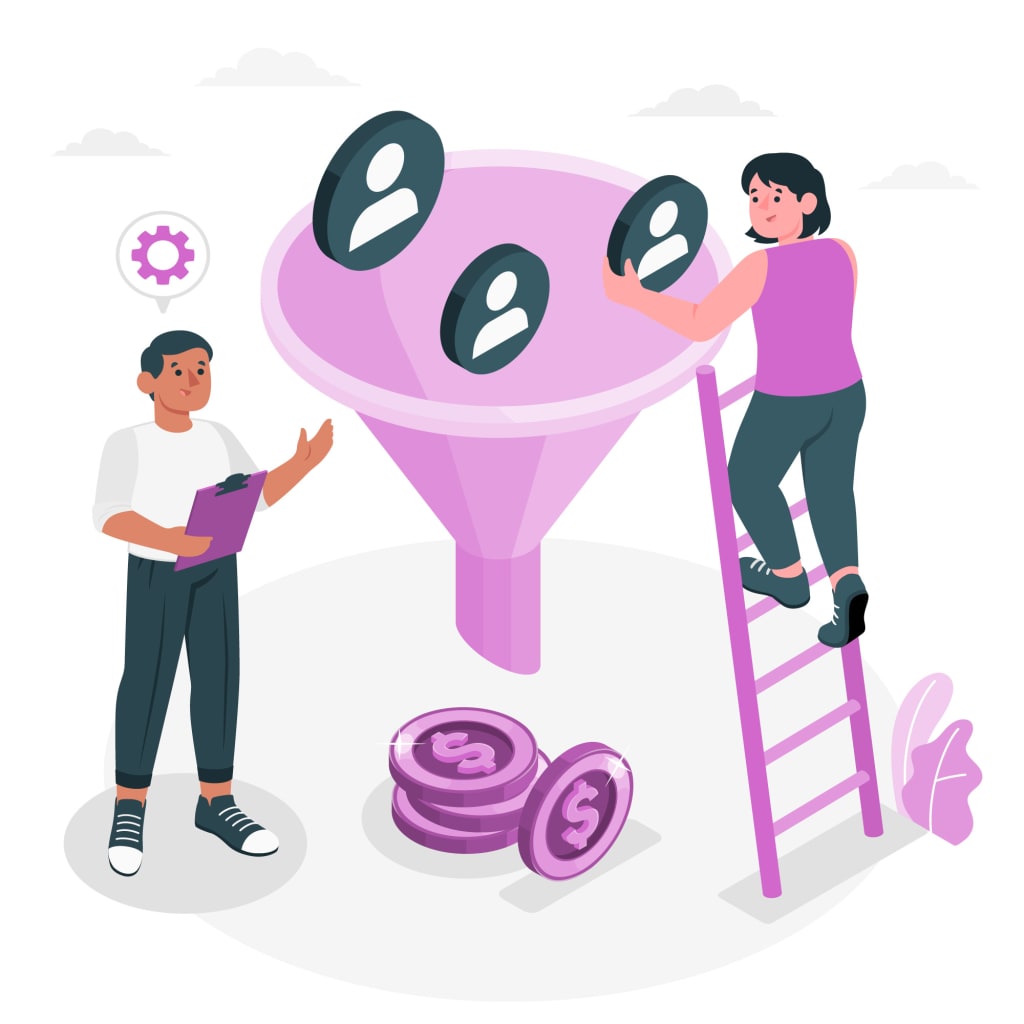Sales Funnel 101: Understanding and Creating Your Business
All about B2B sales funnel and B2C markets.

In digital marketing, the concept of a sales funnel is not just a buzzword but a strategic framework central to driving consumer behavior from Awareness to purchase. This mechanism, crucial for both B2B sales funnel and B2C markets, meticulously guides potential customers through the buyer's journey, leveraging a combination of lead generation, content marketing, and CRM software. By understanding and meticulously crafting a sales funnel, businesses can significantly enhance their ability to attract, engage, and convert their targeted buyer personas into loyal customers. The importance of this strategic tool cannot be overstated, as it blends the art and science of digital marketing to fuel business growth and sustainability.
This article delves into the essence of the sales funnel, from its fundamental concept to its importance in crafting a robust marketing strategy. Readers will traverse the stages of a sales funnel, uncovering how each phase plays a pivotal role in the customer journey. Furthermore, the discourse will navigate through practical steps on how to create a sales funnel, employing effective digital marketing techniques and utilizing CRM software for optimal lead generation. The subsequent sections will offer insights into measuring and optimizing the sales funnel, ensuring that businesses can adapt and thrive in the evolving landscape of B2B and B2C sales, making the dynamics of sales funnel management an essential endeavor for enduring success in the digital age.
What is a Sales Funnel?
A sales funnel, also known as a purchase funnel, is a visual representation of the customer journey, illustrating the sales process from Awareness to Action. This concept, sometimes referred to as a marketing funnel or revenue funnel, highlights the notion that every sale begins with a large pool of potential customers, which eventually narrows down to a smaller group of individuals who make a purchase. The sales funnel is a crucial marketing term that describes the journey potential customers undergo on their way to making a purchase. This journey is typically segmented into several steps, often categorized as the top, middle, and bottom of the funnel. However, the specific steps may vary depending on a company's sales model.
Understanding the Sales Funnel Structure
- Awareness: The top of the funnel, where potential customers first become aware of a product or service.
- Consideration: The middle of the funnel, where interest and evaluation of the product or service occur.
- Decision: The bottom of the funnel, where the final purchase decision is made.
The Significance of a Sales Funnel
A sales funnel is not just a theoretical model but a practical tool that helps businesses understand and influence consumer behavior throughout the buying process. It serves as a visual roadmap, showing exactly where a prospect is in the buying process at any given time. This insight allows businesses to tailor their marketing strategies effectively, increasing conversion rates and sales over time. Moreover, a well-constructed sales funnel without gaps enables companies to guide potential customers through the buying process towards purchase completion. In contrast, funnels with gaps may lead to potential customers dropping out of the sales process.
Sales Funnel Management
Effective sales funnel management involves identifying and plugging the holes in the funnel that may cause potential customers to drop out. Sales and marketing automation software can significantly aid in this process, turning near-misses into sales by ensuring that no prospect is lost due to missed appointments or forgotten follow-ups. The goal of sales funnel management is to narrow down a large number of leads and prospects to a smaller, more manageable number of paying customers.
Understanding the sales funnel is crucial for businesses aiming to convert more targeted leads into customers. Every interaction with customers should align with the strategic framework of the sales funnel, from prospecting to the closing of the deal. As the sale progresses and more information is exchanged, the benefits of the product become clearer to the customer, increasing the likelihood of a successful sale.
Why is a Sales Funnel Important?
Understanding the Customer Journey
A sales funnel is pivotal for comprehending the customer journey and pinpointing where potential customers might be lost. By dissecting each funnel stage, businesses can identify areas needing enhancement and optimize accordingly.
Focusing Marketing Efforts
It enables the concentration of marketing endeavors on the appropriate audience. Crafting buyer personas and grasping the target audience's needs and pain points allows for tailored marketing messages, guiding them effectively through the sales funnel.
Increasing Conversions and Revenue
The sales funnel is instrumental in boosting conversions and revenue. Offering value at each funnel stage builds trust and credibility, which can lead to purchases. Moreover, it facilitates upselling and cross-selling to existing customers, thereby augmenting revenue.
Streamlining the Customer Journey
Having a clear understanding of the sales funnel streamlines the customer journey, enabling businesses to cater precisely to customers' decision-making stages. This clarity allows for more effective assistance in guiding customers to a purchase decision.
Resource Optimization
A well-defined funnel aids in resource optimization, focusing efforts where they can significantly impact. It depends on the business model; efforts may concentrate on the funnel's latter stages or on creating content that speaks directly to various stages.
Forecasting Sales
Funnels serve as an excellent forecasting tool for sales outcomes. They help in setting realistic conversion rate goals and optimizing marketing strategies to increase the likelihood of sales, thereby allowing for accurate measurement and optimization of marketing efforts.
Creating Customers and Generating Referrals
Sales funnels are essential for converting a target audience into customers and encouraging satisfied customers to refer others, expanding the potential customer base.
Monitoring and Tracking
They enable organizations to monitor each sales process step, facilitating timely adjustments and efficient use of sales resources. This feedback loop is crucial for refining sales strategies.
Focusing Efforts
Funnels help narrow down the focus to a specific group of prospects, making it easier to convert them into customers. They also assist in filtering out unqualified prospects, streamlining the path towards purchase.
In summary, sales funnels are indispensable tools for businesses aiming to understand their customers better, optimize marketing efforts, increase sales, and ultimately grow their business. By leveraging the insights and strategies provided by a well-constructed sales funnel, companies can achieve a competitive edge and foster sustainable growth.

Stages of a Sales Funnel
1. Awareness
The journey of a potential buyer in a sales funnel commences with the awareness stage, where the primary goal is to make prospective customers aware of the company and its offerings. This stage acts as the initiation point of the sales funnel process, achieved through various means such as word of mouth, cold calling, email campaigns, and social media content. At this juncture, the audience is broad, encompassing anyone who has come across the brand, marking the beginning of their customer journey.
2. Interest
Following awareness, the Interest stage plays a pivotal role in the sales process. Prospective customers demonstrate their curiosity by engaging with the company, possibly through filling out a form, calling, or messaging. The manner in which a company responds to these expressions of interest sets the tone for future interactions and is critical for advancing the relationship. Providing valuable resources and maintaining a friendly tone can significantly feed this interest, fostering a sense of trust.
3. Evaluation
The evaluation stage involves a deeper exploration by the prospect into the company's offerings. Sales representatives play a crucial role here by answering questions and guiding the prospects towards a purchasing decision. This stage is characterized by the prospect conducting further research to ensure the product or service meets their needs, often comparing it with competitors' offerings. It's a period of critical assessment where the quality of information and interaction can heavily influence the prospect's decision-making process.
4. Engagement
In the engagement stage, maintaining the prospect's attention becomes paramount. Companies employ various strategies such as email outreach and the provision of valuable content like whitepapers and case studies to keep the brand at the forefront of the prospect's mind. This stage aims to nurture the relationship and assist the prospect in making a purchasing decision by constantly offering value. Effective engagement ensures that the prospect remains interested and moves closer to the final decision.
5. Action
The final stage, Action, sees the prospect making their purchasing decision. This stage is the culmination of the sales funnel, where the prospect, having been guided through the previous stages with adequate information and engagement, decides to make a purchase. The focus here is on supporting the potential customer to overcome any last-minute hesitations or barriers to purchase, ensuring a smooth transition to becoming a customer. It's a critical moment where the effectiveness of the entire sales funnel is tested, and the prospect transforms into a customer.
By understanding and effectively managing these stages, businesses can guide their prospects through the sales funnel towards making a purchase, thereby converting leads into valuable customers.
How to Build a Sales Funnel
Analyze Your Audience
Understanding your target audience's needs, preferences, and behaviours is crucial in crafting an effective sales funnel. Begin by identifying your ideal customer profile, including demographic details, behaviours, and pain points. This foundational step ensures that subsequent marketing efforts are tailored and resonant, increasing the likelihood of engagement and conversion.
Capture Audience Attention
At the top of the funnel, your primary goal is to attract potential customers. Employ strategies such as informative blog posts, targeted ads, and a strong social media presence to draw attention. Ensure that your content is engaging and relevant, addressing the common queries and interests of your audience, thus laying a solid groundwork for customer acquisition.
Create Compelling Content
Develop content that addresses the different stages of the buyer's journey. Start with broad, educational content that addresses the audience's pain points at the top of the funnel. As potential customers move deeper into the funnel, offer more detailed content that showcases your products or services as the best solution to their needs. This approach not only informs but also builds trust and positions your brand as an authority.
Engage and Nurture Leads
Once potential customers have shown interest, it's essential to nurture those leads. Use email marketing, personalized content, and targeted campaigns to maintain engagement. Effective lead nurturing should provide valuable information and reassurances to the customer, guiding them through the funnel with a focus on solving their problems and meeting their needs.
Convert and Retain Customers
The final stages of the funnel focus on conversion and retention. Provide clear, compelling calls to Action that encourage purchase decisions and ensure the process is as smooth as possible. After conversion, continue to engage with customers through follow-up communications, special offers, and loyalty programs to encourage repeat business and referrals.
By systematically implementing these strategies, businesses can build a robust sales funnel that not only attracts but also retains customers, thereby enhancing overall business growth and customer satisfaction.
Measuring and Optimizing Your Sales Funnel
Key Metrics to Track
1. Conversion Rates: It's essential to monitor the percentage of leads progressing through each funnel stage. A decline in conversion rates may signal an area needing immediate attention.
2. Customer Acquisition Cost (CAC): Calculating the total cost to acquire a new customer is vital. A high CAC compared to customer lifetime value indicates inefficiencies within the funnel that should be addressed.
3. Customer Lifetime Value (CLTV): Understanding the revenue a customer generates over their lifetime helps determine the investment in new customer acquisition.
4. Cohort Analysis: This analysis tracks customer behaviour over time, providing insights into the long-term value of different customer segments and the effectiveness of the funnel.
Tools for Optimization
1. Google Analytics: A crucial tool for tracking website traffic, user behaviour, and conversion paths, invaluable for understanding how visitors navigate through the funnel.
2. CRM Software: Platforms like Salesforce and HubSpot offer built-in analytics for tracking interactions and conversion rates across funnel stages.
3. A/B Testing Tools: Tools such as Optimizely or Unbounce are essential for conducting A/B tests on various elements like landing pages and emails to identify the most effective strategies.
Strategies for Continuous Improvement
1. Data-Driven Decision Making: Implementing robust tracking and analytics tools is the first step to gathering insights for funnel optimization. Monitoring key metrics like conversion rates and customer lifetime value is crucial for identifying improvement areas.
2. Conduct A/B Testing: A/B testing is a potent technique for optimizing funnel elements, including ad creatives and email subject lines. Experimenting with different content and offering variations can significantly enhance conversion rates.
3. Customer Feedback: Actively soliciting and listening to customer feedback through surveys and social media channels offers valuable insights into the funnel's performance and areas for enhancement.
4. Stay Updated on Industry Trends: Keeping abreast of the latest digital marketing trends and innovations is essential for funnel optimization.
5. Regular Review and Iteration: Setting aside regular intervals for reviewing funnel performance metrics and making iterative improvements based on data analysis is vital for driving better results over time.
Conclusion
In conclusion, mastering the art of the sales funnel is essential for any business looking to thrive in today's digital landscape. By understanding the structure of the funnel, recognizing its significance, and implementing best practices for creation and optimization, you can attract, engage, and convert prospects into loyal customers. Remember, the key to success lies in delivering value, fostering relationships, and continuously adapting to meet the ever-changing needs of your audience. So, roll up your sleeves, dive in, and start building your high-converting sales funnel today. Your bottom line will thank you for it.
About the Creator
Enjoyed the story? Support the Creator.
Subscribe for free to receive all their stories in your feed. You could also pledge your support or give them a one-off tip, letting them know you appreciate their work.





Comments
There are no comments for this story
Be the first to respond and start the conversation.